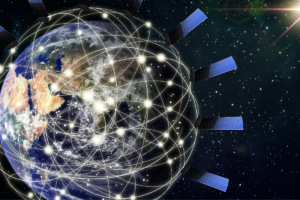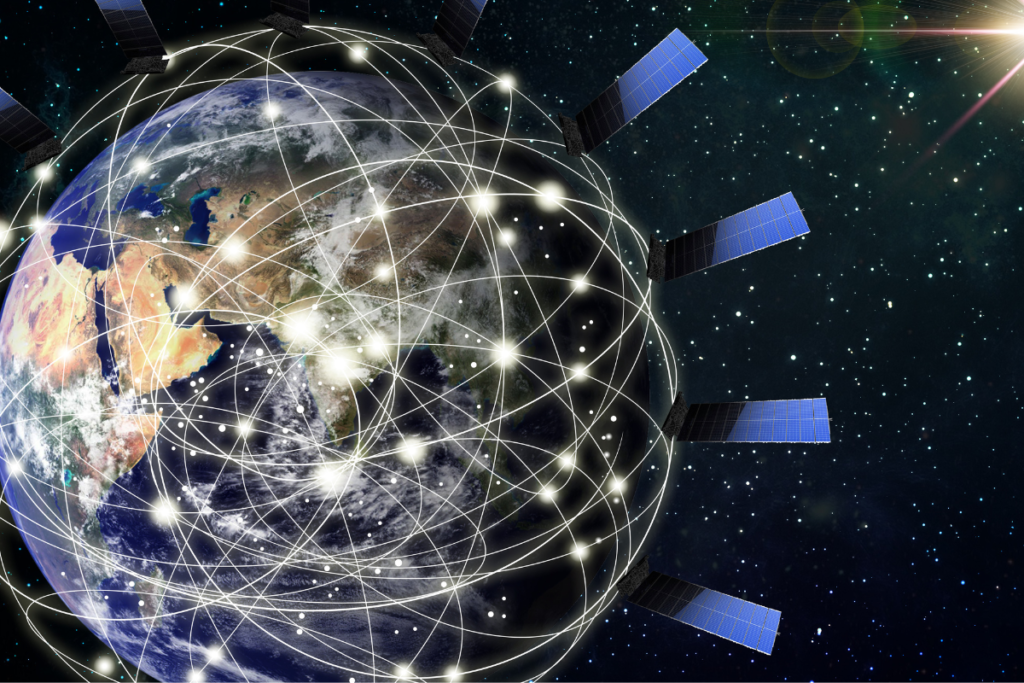Introduction to Artificial Satellites
Ever looked up at the night sky and wondered how that small dot of light, which isn’t a star, moves so effortlessly across the heavens? That dot is likely an artificial satellite orbiting Earth. Satellites have become an essential part of our daily lives, powering everything from our GPS navigation to global communications. But have you ever stopped to consider the incredible speeds these satellites must maintain to stay in orbit? For many satellites in Low Earth Orbit (LEO), that speed is a staggering 7800 meters per second (m/s). In this article, we’ll explore why this specific speed is crucial, how it’s achieved, and the science that keeps these marvels of technology spinning above us.
Understanding Satellite Orbits
What is an Orbit?
An orbit is the path that a satellite follows around a planet, in this case, Earth. It’s like a racetrack in space, but instead of gravity pulling the satellite down, it helps keep the satellite on its path. The balance between the satellite’s speed and Earth’s gravitational pull creates a stable orbit, allowing the satellite to circle the planet without falling back to Earth or shooting off into space.
The Role of Gravity in Satellite Orbits
Gravity plays a crucial role in determining the orbit of a satellite. It’s the invisible hand that guides satellites along their paths. Without gravity, a satellite would continue in a straight line out into space. Conversely, without the satellite’s speed, gravity would pull it back to Earth. The balance between these two forces keeps the satellite in orbit.
Types of Satellite Orbits
Satellites can orbit Earth at various altitudes, each with its own set of characteristics and purposes.
Low Earth Orbit (LEO)
LEO is the closest to Earth, ranging from about 160 to 2,000 kilometers above the planet’s surface. Satellites in LEO travel at high speeds (around 7800 m/s) to stay in orbit and are used for things like Earth observation, weather monitoring, and the International Space Station.
Medium Earth Orbit (MEO)
MEO lies between LEO and Geostationary Orbit, typically between 2,000 to 35,786 kilometers above Earth. Navigation systems like GPS satellites often operate in this zone.
Geostationary Orbit (GEO)
Satellites in GEO orbit at about 35,786 kilometers above Earth’s equator and appear to remain stationary over a single point on the planet’s surface. This makes them ideal for communication and weather satellites.
Polar Orbit
Polar orbits pass over the Earth’s poles, allowing satellites to scan the entire globe over time. These orbits are often used for Earth observation and reconnaissance.
The Science Behind a Speed of 7800 m/s
How Speed Affects Orbit Stability
The speed at which a satellite orbits is critical to maintaining a stable path around Earth. If the satellite is too slow, gravity will pull it back to Earth. If it’s too fast, it could escape Earth’s gravity altogether. The speed of 7800 m/s is just right for satellites in LEO, balancing the gravitational pull and the satellite’s momentum.
Calculating Orbital Speed
The speed of a satellite in orbit depends on its altitude. The lower the orbit, the higher the speed required to counteract Earth’s gravity. This is why LEO satellites, which are closer to Earth, need to move faster than those in higher orbits. The 7800 m/s speed is calculated based on the gravitational pull at LEO’s altitude and the need to maintain a circular orbit.
Why 7800 m/s? The Sweet Spot for LEO Satellites
At 7800 m/s, a satellite in LEO can complete an orbit around Earth in about 90 minutes. This speed ensures that the satellite stays in a stable orbit without the risk of falling back to Earth or drifting off into space. It’s the perfect balance for the altitude, offering both stability and efficiency.
Factors Influencing Satellite Speed
Altitude of the Satellite
The altitude of a satellite directly influences its required orbital speed. As we’ve discussed, satellites closer to Earth need to travel faster. This is why LEO satellites zip around at 7800 m/s, while those in GEO, much farther away, move at a slower pace.
Gravitational Forces
Gravity is stronger the closer you are to Earth. This means satellites in LEO face a stronger gravitational pull, necessitating higher speeds to maintain their orbit. The balance between speed and gravity ensures the satellite stays in a consistent orbit.
Atmospheric Drag and Its Impact
Even at the altitudes of LEO, there are still traces of Earth’s atmosphere. This thin air can slow down satellites over time, leading to orbital decay. Satellites must occasionally adjust their speed to counteract this drag and maintain their proper orbit.
The Importance of Precise Satellite Speed
Maintaining a Stable Orbit
Precise speed is crucial for maintaining a satellite’s orbit. Any deviation can cause the satellite to drift off course, leading to potential mission failure. Engineers carefully calculate and monitor the speed to ensure that the satellite stays on track.
Avoiding Orbital Decay
Orbital decay occurs when a satellite loses speed due to atmospheric drag, causing it to slowly descend towards Earth. Maintaining the correct speed of 7800 m/s helps prevent this, ensuring the satellite remains operational for its intended lifespan.
Ensuring Effective Satellite Operations
Satellites have specific tasks to perform, whether it’s capturing images of Earth, relaying communications, or monitoring the weather. Maintaining the correct speed ensures that they remain in the right position to carry out these tasks effectively.
How Satellites Achieve and Maintain Speed
The Role of Rockets in Satellite Launch
Achieving the necessary speed begins with the launch. Rockets propel satellites into space, providing the initial velocity required to reach orbit. Once in space, the satellite’s speed is fine-tuned to achieve the desired orbit.
In-Orbit Adjustments and Thrusters
Once in orbit, satellites rely on small thrusters to make adjustments to their speed and position. These adjustments are necessary to counteract forces like atmospheric drag or gravitational influences from other celestial bodies.
Monitoring and Controlling Speed from Earth
Ground control teams constantly monitor satellites, ensuring they maintain the correct speed and orbit. If any deviations are detected, commands are sent to the satellite to adjust its thrusters and correct its course.
Real-World Applications of Satellites Orbiting at 7800 m/s
Communication Satellites
Communication satellites in LEO orbit at 7800 m/s to provide rapid data transmission across the globe. These satellites are vital for everything from internet services to international phone calls.
Earth Observation and Remote Sensing
Satellites in LEO, orbiting at this high speed, are perfect for Earth observation. They can capture high-resolution images and monitor environmental changes, providing valuable data for scientists and governments.
Navigation and GPS Satellites
GPS satellites often operate in higher orbits, but some in LEO rely on the 7800 m/s speed to provide accurate location data. These satellites help guide everything from your car to airplanes, ensuring you reach your destination safely.
Challenges in Maintaining Satellite Speed
Space Debris and Collision Risks
Space is becoming increasingly crowded with debris, which poses a significant risk to satellites. Even a small piece of debris can cause catastrophic damage at orbital speeds. Maintaining precise speed and orbit helps satellites avoid collisions.
Orbital Drift and Speed Corrections
Over time, various factors can cause a satellite to drift from its intended orbit. Regular speed corrections are necessary to keep the satellite in its designated path, ensuring it continues to function correctly.
The Threat of Space Weather
Solar flares and other space weather events can impact a satellite’s speed and orbit. These phenomena can increase atmospheric drag or alter the satellite’s electronics, requiring adjustments to maintain speed.
Innovations in Satellite Technology
Advances in Propulsion Systems
New propulsion technologies, such as ion thrusters, are helping satellites achieve more precise speed control. These advancements allow for more efficient in-orbit adjustments, extending the satellite’s operational life.
The Role of AI in Speed Management
Artificial intelligence is increasingly being used to manage satellite speed and orbit. AI can make real-time adjustments, ensuring the satellite remains in its optimal orbit without constant human intervention.

Future Trends in Satellite Design
As technology advances, satellites are becoming smaller, more efficient, and better equipped to handle the challenges of space. These innovations will allow future satellites to maintain their speed and orbit more effectively, even in the face of increasing space traffic.
The Future of Satellites Orbiting Earth
Increasing Satellite Traffic and Its Implications
The number of satellites in orbit is expected to increase dramatically in the coming years. This will require more precise speed control and better coordination to prevent collisions and maintain efficient operations.
Emerging Technologies to Improve Speed Control
New technologies, such as autonomous propulsion systems and AI-driven control, will play a significant role in managing satellite speed. These innovations will help satellites operate more safely and efficiently in crowded orbits.
The Role of International Regulations
As space becomes more crowded, international regulations will be crucial in managing satellite traffic and ensuring safe operations. These regulations will likely include guidelines for maintaining speed and avoiding collisions.
#SatelliteCircularOrbitAbouttheEarth #AIAccounts #OrbitingSpaceStation #RemoteSatellite
Conclusion
Satellites orbiting Earth at a speed of 7800 m/s are a marvel of modern technology. This precise speed allows them to maintain stable orbits, perform their designated tasks, and contribute to everything from global communications to environmental monitoring. As space becomes more crowded and technology advances, maintaining and controlling this speed will be more important than ever. The future of satellites is bright, and their role in our daily lives will only continue to grow.
FAQs
- How does a satellite maintain its speed in orbit?
- Satellites maintain their speed through a combination of initial launch velocity provided by rockets and small in-orbit adjustments using thrusters to counteract factors like atmospheric drag and gravitational forces.
- What happens if a satellite’s speed changes in orbit?
- If a satellite’s speed decreases, it may experience orbital decay and eventually fall back to Earth. If its speed increases, it could drift into a higher orbit or even escape Earth’s gravity.
- Why is 7800 m/s the optimal speed for LEO satellites?
- 7800 m/s is the optimal speed for LEO satellites because it balances Earth’s gravitational pull, allowing the satellite to maintain a stable orbit without falling back to Earth or drifting away.
- Can satellites orbit at speeds higher or lower than 7800 m/s?
- Yes, satellites can orbit at different speeds depending on their altitude. Higher orbits require lower speeds, while lower orbits require higher speeds to maintain stability.
- How do satellites avoid collisions with space debris?
- Satellites avoid collisions through careful monitoring by ground control, which can make adjustments to the satellite’s speed and trajectory to steer clear of debris. Emerging technologies like AI also play a role in collision avoidance.


